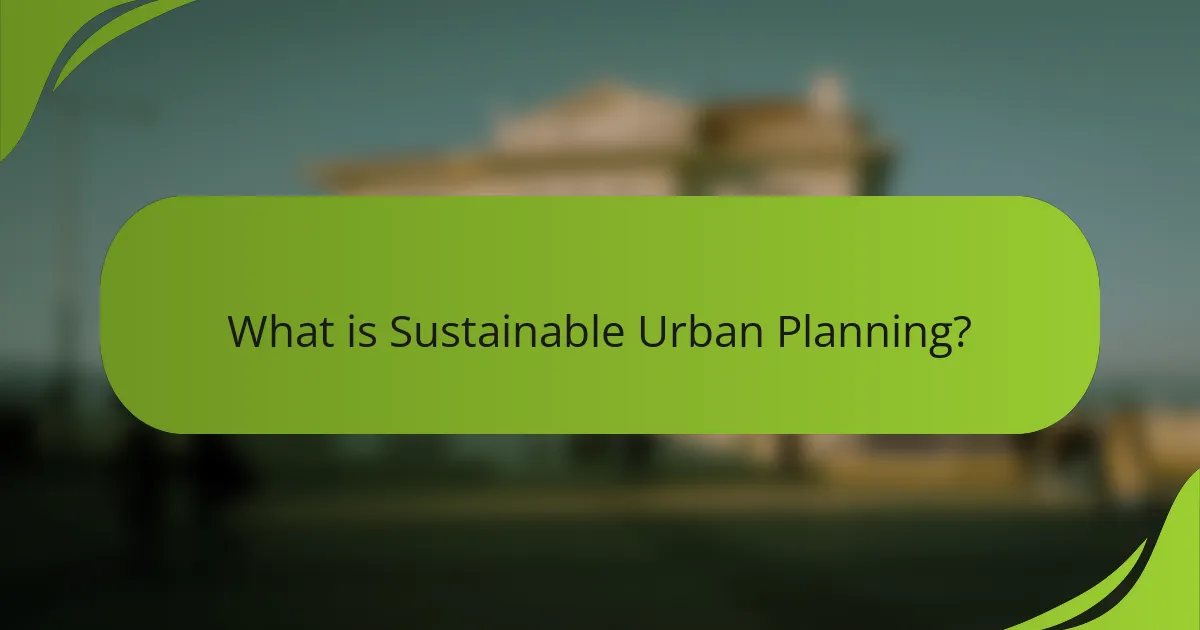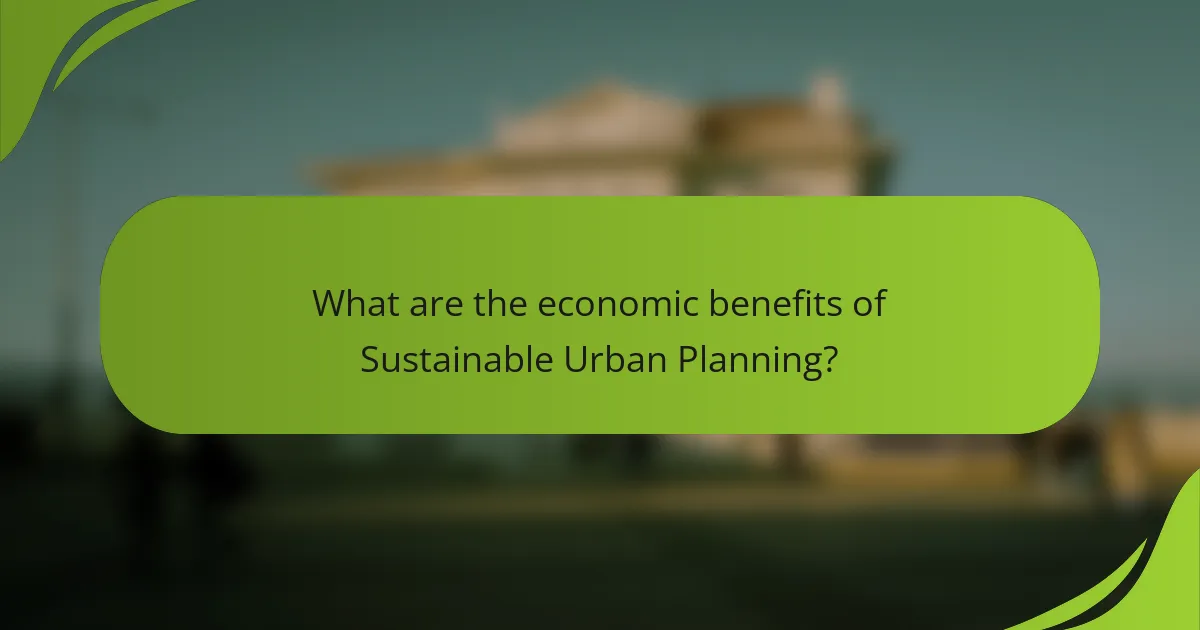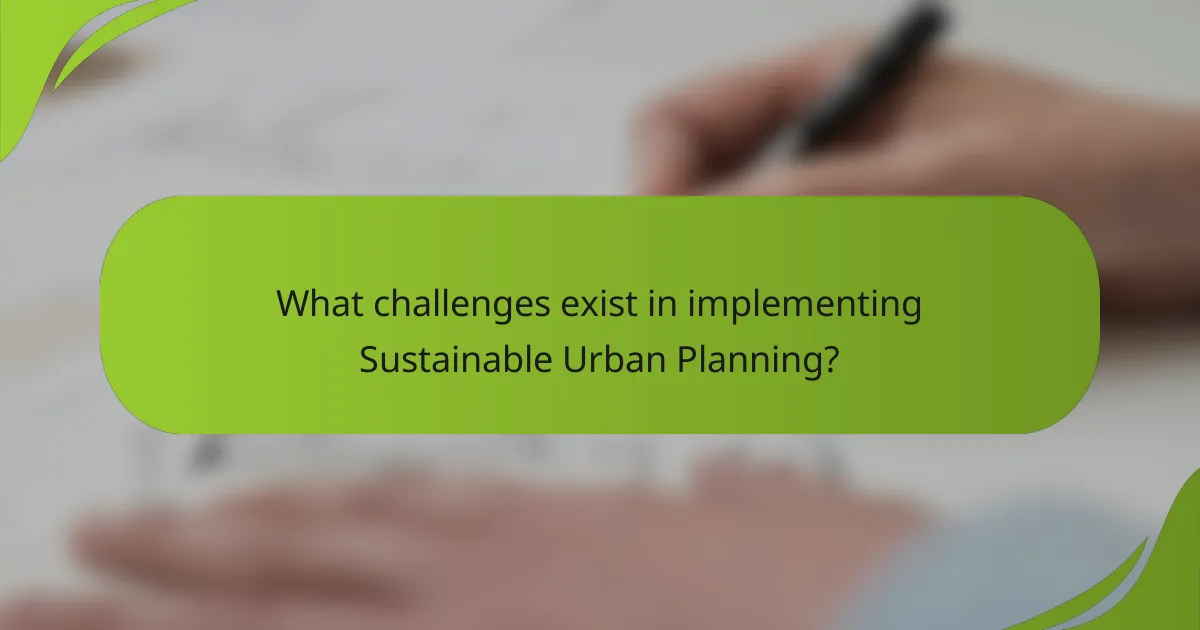Sustainable urban planning is a strategic approach to designing cities that addresses current needs while safeguarding resources for future generations. This methodology incorporates environmental, social, and economic factors to enhance land use, reduce waste, and improve quality of life. Key components include community engagement, the promotion of public transportation, green spaces, and the use of renewable energy sources. The article explores the economic advantages of sustainable urban planning, such as job creation and increased property values, while also addressing challenges like funding limitations, political resistance, and outdated regulations. Overall, it highlights the importance of sustainable practices in fostering resilient and adaptable urban communities.

What is Sustainable Urban Planning?
Sustainable urban planning is a strategy for designing cities that meet current needs without compromising future generations. It integrates environmental, social, and economic considerations into urban development. This approach promotes efficient land use, reduces waste, and enhances quality of life. Sustainable urban planning aims to create resilient communities that can adapt to changing conditions. It often involves community engagement to ensure diverse needs are met. This planning method also emphasizes public transportation, green spaces, and renewable energy sources. According to the UN, sustainable urbanization can significantly reduce greenhouse gas emissions and improve urban living conditions.
How does Sustainable Urban Planning differ from traditional urban planning?
Sustainable Urban Planning focuses on long-term ecological balance while traditional urban planning often prioritizes immediate development needs. Sustainable approaches integrate environmental considerations into land use, transportation, and resource management. Traditional planning typically emphasizes economic growth with less regard for environmental impacts.
Sustainable Urban Planning promotes mixed-use developments to reduce dependency on cars. It encourages green spaces and biodiversity, enhancing urban resilience. Traditional planning may lead to urban sprawl and increased pollution due to car-centric designs.
Research indicates that sustainable practices can reduce greenhouse gas emissions by 30% in urban areas. This evidence supports the effectiveness of sustainable strategies in combating climate change.
What are the key principles of Sustainable Urban Planning?
The key principles of Sustainable Urban Planning include environmental sustainability, social equity, and economic viability. Environmental sustainability focuses on minimizing ecological impact. This involves promoting green spaces, reducing pollution, and conserving resources. Social equity ensures that all community members have access to essential services and opportunities. This principle emphasizes inclusivity in decision-making processes. Economic viability aims for long-term financial health of urban areas. It encourages investment in infrastructure and local businesses. These principles work together to create resilient and adaptable urban environments.
Why is sustainability important in urban environments?
Sustainability is crucial in urban environments because it promotes ecological balance and resource efficiency. Urban areas face significant challenges such as pollution, waste management, and resource depletion. Implementing sustainable practices helps reduce carbon footprints and enhances air quality. For instance, cities that adopt green infrastructure can mitigate stormwater runoff and improve biodiversity. Research shows that sustainable urban planning can lead to economic benefits, with a potential increase in property values by 20% in areas with green spaces. Furthermore, sustainable practices in cities can create jobs in renewable energy and green construction sectors. Overall, sustainability is essential for fostering resilient, livable, and economically viable urban communities.
What are the core components of Sustainable Urban Planning?
The core components of Sustainable Urban Planning include land use, transportation, and environmental sustainability. Land use involves the strategic allocation of space for residential, commercial, and recreational purposes. Transportation focuses on creating efficient and accessible transit systems that reduce reliance on cars. Environmental sustainability emphasizes the preservation of natural resources and ecosystems. Community engagement ensures that the voices of residents are considered in planning decisions. Economic benefits arise from increased property values and reduced infrastructure costs. These components work together to create livable, resilient urban environments.
How does land use planning contribute to sustainability?
Land use planning contributes to sustainability by promoting efficient resource use and reducing environmental impact. It facilitates the development of compact, mixed-use communities. These communities minimize reliance on automobiles, thereby reducing greenhouse gas emissions. Effective land use planning also protects natural habitats and biodiversity. According to the American Planning Association, well-planned urban areas can reduce energy consumption by up to 30%. Furthermore, it encourages green spaces, which enhance air quality and improve public health. By integrating sustainability principles, land use planning fosters long-term economic viability and resilience.
What role does transportation play in Sustainable Urban Planning?
Transportation is a crucial component of Sustainable Urban Planning. It shapes the accessibility and mobility within urban areas. Efficient transportation systems reduce reliance on personal vehicles. This leads to lower greenhouse gas emissions and improved air quality. Public transit options, like buses and trains, encourage sustainable commuting habits. Integrating walking and cycling infrastructure promotes healthier lifestyles. Studies show that cities with robust public transport systems have higher economic growth. Sustainable transportation planning enhances community connectivity and quality of life.
How does community engagement enhance Sustainable Urban Planning?
Community engagement enhances sustainable urban planning by incorporating diverse perspectives and local knowledge. This participation leads to more relevant and accepted planning outcomes. Engaged communities can identify specific needs and priorities, ensuring that developments reflect their values. Research shows that projects with community involvement are more likely to succeed and be sustainable over time. For instance, a study published in the Journal of Urban Affairs found that community-driven initiatives improve environmental sustainability and social equity. Additionally, engaged communities foster a sense of ownership and responsibility, which can lead to better maintenance of urban spaces. This collaborative approach ultimately results in more resilient and adaptive urban environments.
Why is public participation crucial in the planning process?
Public participation is crucial in the planning process because it ensures that diverse community perspectives are considered. Engaging the public leads to more informed decision-making. It helps identify local needs and priorities, which may not be apparent to planners. Public input can enhance the legitimacy of planning outcomes. Studies show that projects with public engagement often experience higher levels of community support. For example, the American Planning Association emphasizes that involving citizens can improve project success rates. Furthermore, public participation can foster a sense of ownership among community members. This ownership can lead to increased civic responsibility and stewardship of local resources.
What methods can be used to engage the community effectively?
Effective methods to engage the community include participatory planning, workshops, and surveys. Participatory planning allows community members to contribute to decision-making. Workshops facilitate direct interaction and brainstorming among residents. Surveys gather feedback on community needs and preferences. These methods encourage transparency and build trust. Studies show that inclusive engagement leads to higher satisfaction with urban development. For example, the American Planning Association highlights that communities involved in planning processes report better outcomes. Engaging the community fosters a sense of ownership and responsibility towards local initiatives.

What are the economic benefits of Sustainable Urban Planning?
Sustainable Urban Planning provides significant economic benefits. It boosts local economies by creating jobs in construction and green industries. These jobs often pay higher wages than traditional sectors. Sustainable practices reduce infrastructure costs through efficient resource use. For instance, energy-efficient buildings lower utility expenses for residents and businesses. Additionally, improved public transportation can enhance accessibility, increasing local commerce. Studies show that cities with sustainable planning attract more investments. This influx can lead to enhanced property values and increased tax revenues. Overall, Sustainable Urban Planning fosters economic resilience and growth.
How does Sustainable Urban Planning impact local economies?
Sustainable urban planning positively impacts local economies by promoting efficient land use and resource management. It fosters job creation through green infrastructure projects and sustainable business practices. A study by the American Planning Association found that sustainable planning can increase property values by 10-20%. This increase in property values leads to higher tax revenues for local governments. Additionally, sustainable urban planning enhances the quality of life, attracting new residents and businesses. Improved public transportation and walkable neighborhoods reduce transportation costs for families. This, in turn, allows residents to spend more on local goods and services. Overall, sustainable urban planning stimulates economic growth while ensuring environmental protection.
What are the cost savings associated with sustainable practices?
Sustainable practices lead to significant cost savings for organizations and communities. These savings stem from reduced energy consumption, lower waste disposal costs, and decreased water usage. For example, energy-efficient buildings can save up to 30% on energy bills annually. Implementing recycling programs can cut waste management costs by 20% or more. Additionally, sustainable transportation options can reduce fuel expenses for cities. According to the U.S. Environmental Protection Agency, sustainable practices can yield a return on investment of up to 200% over time. These financial benefits encourage broader adoption of sustainable strategies in urban planning.
How can Sustainable Urban Planning attract investment?
Sustainable urban planning can attract investment by creating environments that promote economic growth and sustainability. It enhances property values through green spaces and efficient infrastructure. Investors are drawn to areas with reduced environmental risks and improved quality of life. A study by the Urban Land Institute found that developments incorporating sustainability features can see a 10-20% increase in investment returns. Moreover, sustainable practices can lower operational costs, making projects more appealing. Cities with clear sustainability goals often receive grants and incentives, further attracting funding. The integration of community engagement in planning fosters public support, which is vital for investor confidence.
What are the long-term economic advantages of Sustainable Urban Planning?
Sustainable Urban Planning provides long-term economic advantages such as increased property values and reduced infrastructure costs. It promotes efficient land use, which can lead to higher density developments. Higher density developments often attract businesses and residents, boosting local economies. Sustainable practices reduce energy consumption, leading to lower utility costs for residents and businesses.
Additionally, sustainable urban areas tend to attract tourism, which further stimulates economic growth. Research indicates that cities with green spaces and sustainable design see a rise in tourism revenue. For example, a study by the Urban Land Institute found that walkable neighborhoods can increase property values by 20%.
Furthermore, sustainable urban planning can lead to job creation in green industries. As cities invest in renewable energy and sustainable infrastructure, new employment opportunities arise. Overall, these factors contribute to a resilient and thriving economy in the long term.
How does sustainability influence property values?
Sustainability positively influences property values. Properties with sustainable features often attract higher demand. This demand results from growing consumer preference for eco-friendly living. Energy-efficient homes can sell for 2-10% more than traditional homes. A study by the National Association of Realtors found that 61% of homebuyers prefer energy-efficient properties. Additionally, properties in sustainable neighborhoods often experience lower vacancy rates. Sustainable urban planning can enhance community appeal, further increasing property values. Overall, sustainability is a key factor in modern real estate valuation.
What are the job creation opportunities within sustainable initiatives?
Sustainable initiatives create job opportunities in various sectors. Renewable energy projects require skilled workers for installation and maintenance. Green construction jobs arise from building energy-efficient structures. Urban farming initiatives generate positions in food production and distribution. Waste management programs create roles in recycling and composting. Transportation improvements lead to jobs in public transit and infrastructure development. According to the International Renewable Energy Agency, the renewable energy sector employed over 11 million people globally in 2018. This growth indicates strong future job potential within sustainable initiatives.

What challenges exist in implementing Sustainable Urban Planning?
Implementing Sustainable Urban Planning faces several challenges. Limited funding is a significant barrier. Many municipalities struggle to allocate sufficient resources for sustainable initiatives. Additionally, political resistance often hinders progress. Decision-makers may prioritize short-term gains over long-term sustainability. Public awareness and engagement are also critical issues. Communities may lack understanding of sustainable practices, leading to pushback. Furthermore, regulatory frameworks can be outdated or inadequate. These regulations may not support innovative sustainable solutions. Lastly, data availability poses a challenge. Reliable data is essential for informed decision-making in urban planning.
What are the common obstacles faced by planners?
Planners commonly face obstacles such as budget constraints, regulatory hurdles, and community opposition. Budget constraints limit the resources available for projects. Regulatory hurdles involve navigating complex zoning laws and building codes. Community opposition can arise from residents’ concerns about changes in their neighborhoods. Limited data availability can hinder effective decision-making. Time constraints often pressure planners to meet deadlines. Stakeholder coordination is necessary but can be challenging. Environmental considerations must also be addressed, adding complexity to planning efforts. These obstacles can significantly impact the success of sustainable urban planning initiatives.
How can funding limitations affect sustainable projects?
Funding limitations can significantly hinder sustainable projects. Limited financial resources restrict the scope and scale of these initiatives. Projects may face delays or be scaled back due to insufficient funding. This can lead to compromised quality and effectiveness of sustainability efforts. For instance, a lack of funds can prevent the use of advanced technologies or materials. Additionally, funding constraints can limit community engagement and outreach efforts. Successful sustainable projects often require collaboration and input from various stakeholders. Without adequate funding, these essential interactions may not occur. Ultimately, funding limitations can undermine the long-term viability of sustainable projects.
What role do regulations play in Sustainable Urban Planning?
Regulations play a crucial role in Sustainable Urban Planning by establishing guidelines for land use and development. These regulations ensure that urban growth aligns with sustainability goals. They promote environmental protection, resource conservation, and social equity. Zoning laws, for example, dictate land use types and densities. Building codes ensure structures meet safety and sustainability standards. Environmental regulations protect natural resources from degradation. Additionally, regulations facilitate community engagement in the planning process. They provide a framework for public input and collaboration. This helps address the needs and concerns of local residents. Overall, regulations are essential for creating sustainable and livable urban environments.
How can stakeholders overcome challenges in Sustainable Urban Planning?
Stakeholders can overcome challenges in Sustainable Urban Planning by fostering collaboration among diverse groups. Effective communication is essential to align goals and share resources. Engaging the community ensures that local needs are addressed. Utilizing data-driven decision-making enhances transparency and trust. Additionally, stakeholders should prioritize long-term sustainability over short-term gains. Implementing innovative financing models can secure necessary funding. Regular training and education for stakeholders can improve skills and knowledge. Lastly, adapting to changing conditions and feedback is crucial for ongoing success.
What best practices can be adopted for successful implementation?
Best practices for successful implementation in sustainable urban planning include stakeholder engagement, clear communication, and adaptive management. Engaging stakeholders fosters collaboration and ensures diverse perspectives are considered. Clear communication helps articulate goals and updates, keeping all parties informed. Adaptive management allows for flexibility in response to changing circumstances and feedback. Research indicates that projects with strong stakeholder involvement have higher success rates. The National Institute of Urban Affairs highlights that effective community engagement leads to better outcomes and increased public support.
How can collaboration between stakeholders improve outcomes?
Collaboration between stakeholders can improve outcomes in sustainable urban planning by fostering shared goals and resources. When stakeholders, such as government agencies, community groups, and private sectors, work together, they can leverage diverse expertise. This collaboration leads to more comprehensive solutions that address multiple needs and perspectives. For instance, a study by the National Academy of Sciences indicates that collaborative approaches can enhance project efficiency and effectiveness. Engaging various stakeholders ensures that the voices of the community are heard, leading to higher satisfaction and better acceptance of urban initiatives. Additionally, shared decision-making can reduce conflicts and streamline processes, ultimately resulting in more sustainable and resilient urban environments.
What practical steps can communities take to promote Sustainable Urban Planning?
Communities can promote Sustainable Urban Planning by implementing several practical steps. First, they can encourage local participation in planning processes. Engaging community members fosters a sense of ownership and accountability. Second, communities should prioritize green spaces in urban designs. Green spaces improve air quality and enhance biodiversity. Third, they can adopt mixed-use zoning regulations. This approach reduces reliance on cars and promotes walkability. Fourth, communities can invest in public transportation systems. Efficient public transit decreases traffic congestion and lowers carbon emissions. Fifth, they should support energy-efficient building practices. Energy-efficient buildings reduce energy consumption and lower utility costs. Lastly, communities can create policies that incentivize sustainable practices. Incentives can motivate businesses and residents to adopt eco-friendly solutions. These steps collectively contribute to more sustainable urban environments.
Sustainable Urban Planning is a strategic approach to city design that balances environmental, social, and economic needs to create resilient communities. The article explores the principles of sustainable urban planning, including environmental sustainability, social equity, and economic viability, while contrasting it with traditional urban planning methods. It emphasizes the importance of community engagement in the planning process and outlines the economic benefits, such as job creation and increased property values, associated with sustainable practices. Additionally, the article addresses challenges faced in implementation and offers practical steps for communities to promote sustainability in urban environments.